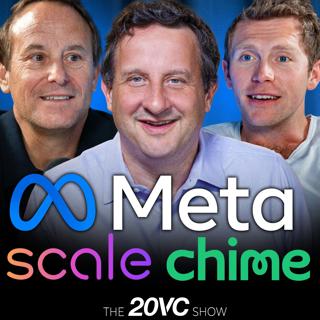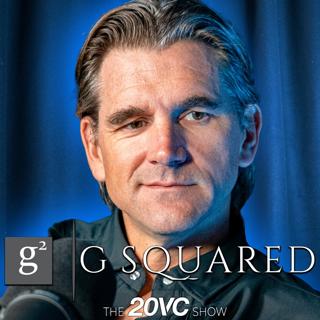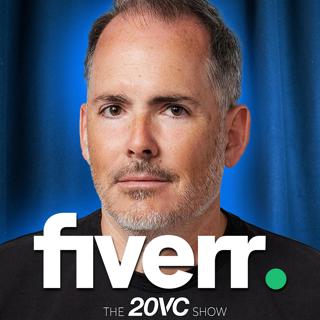
20VC: The Wild Story Raising $450M From Masa and Softbank | Why My Biggest Mistakes Came From Listening to VCs | Why 100 VCs Turned Us Down | Why European Founders Are Tougher Than US Founders with Johannes Reck, GetYourGuide
Johannes Reck is the Founder and CEO of GetYourGuide, the $2BN company that started with a holiday to China and nothing to do. For the first two years, GetYourGuide received only 5 bookings. Today the platform is worth $2BN. They have raised from some of the best, including an amazing story with Masa Son and Softbank. In Today's Episode We Discuss: 01:45 – "I Regret Our Series A — Too Much Dilution" 03:50 – US vs Europe: Why European Founders Are Tougher 06:10 – "Germany Spends €100B on Pensions, €7B on VC – It's Insane" 08:40 – Why Europe Fails to Build $10B Startups 10:25 – 90% of Our Team in Berlin Aren't German. Here's Why. 12:20 – Recruiting Netflix's Head of Growth Nearly Killed Me 16:20 – "We Had 5 Bookings in 2 Years. 3 Were My Mum." 18:00 – "I Asked My Parents to Remortgage Their House for a Pivot" 21:15 – The Vatican Tour That Changed Everything 23:30 – Why VCs Rejected GetYourGuide 100+ Times 28:30 – The $14M Series A That Nearly Killed the Company 31:00 – "I Hired All the Wrong People – Then Laid Off 30%" 36:30 – The $450M SoftBank Deal... Then COVID Hit 40:00 – "We Went to $0 in Revenue in 3 Weeks" 42:10 – The Sequoia Tree Mindset: Grow Through Fire 49:30 – What SoftBank's Masa Son Was Really Like in Person 52:00 – How He Thinks About Secondary, Wealth, and Not Losing His Soul 55:30 – "My Worst Hires Came from Listening to VCs Too Much" 58:30 – Angel Investing in Trade Republic and TravelPerk: My Lessons 01:01:00 – Do You Have to Work 7 Days a Week to Win?
23 Juni 1h 16min

20Product: How Duolingo Build Product 10x Faster with AI | Duolingo's Biggest Lessons on Paywalls, Push Notifications and In-App Purchases | Why Small Teams are the Future of Product | Why PMs Will Become Extinct with Cem Kansu, CPO @ Duolingo
Cem Kansu is the Chief Product Officer at Duolingo, where he leads product strategy for over 90 million monthly active learners. Since joining Duolingo, Cem has played a pivotal role in driving record user engagement, revenue growth, and product innovation, including the launch of Duolingo Math and the wildly successful Duolingo Music. Under his leadership, the company has consistently ranked as the #1 education app globally. In Today's Episode We Discuss: 04:12 – Cem's Origin Story: From Google Ads to Saving Duolingo's Business 06:45 – "Mini CEO" Myth: Why PMs Need to Ditch the Ego 08:55 – The Truth About Design Speed and Pixel Perfection 11:30 – The INSANE Story Behind Duolingo's Viral Chess Launch 14:42 – Why Smaller Teams Are the Future of Product 17:20 – Duolingo's AI Playbook: How They're Building 10x Faster 20:05 – Will Engineers Even Exist in 5 Years? Cem Gets Real 26:10 – Do AI Tools Have ANY Defensibility? Cem Doesn't Hold Back 29:00 – Why Duolingo Took So Long to Monetize (And What They Learned) 33:05 – Cem on Killing Ads, Tasteful Monetization, and Investor Doubt 38:30 – The Secret to Duolingo's Paywall Strategy (And What Not to Do) 42:05 – Cem's Weirdest Retention Hack? A Single Emoji… 46:25 – The Crazy Science Behind Push Notifications at Duolingo 50:00 – In-App Purchases Done Right: GEMS, Freeze, and the Psychology of Value 53:15 – Why Cem Thinks Daily Retention Is the King Metric 55:10 – The ONE Product Feature That Changed Duolingo Forever 57:45 – Will Duolingo Become the Disney of Gen Z? 01:00:00 – Dating on Duolingo?! Cem Reacts to Harry's Craziest Product Ideas 01:03:45 – Cem's Biggest Product Mistakes — And What He'd Kill Tomorrow 01:12:00 – The One Thing Every PM Must Do to Survive the AI Wave 01:14:00 – Duolingo in 20 Years: Cem's Wildest Vision Yet
20 Juni 1h 19min

20VC: Scale's $14.8BN Acquisition: Is Scale a Dead Man Walking / What Did Meta Buy | Chime IPO: Are IPOs Hotter Than Ever | Ramp Hits $16BN Diluting Only 1% | Salesforce, Slack and Dropbox Falling Behind: Are Incumbents Losing Ground
Agenda: 00:00 – Meta's $14.8B Deal for Scale: The Analysis 05:40 – Will Scale Lose Their $800M ARR? Will All Customers Leave? 13:00 – Who is the Winner from All Scale Customers Leaving? 21:30 – Who Made the Most Money From Scale? 24:00 – LPs Just Got $14B Back. Are They Reinvesting? 26:45 – Chime IPO: The Breakdown 29:20 – Ramp Hits $16B Valuation: Are We Back in 2021? 31:10 – Ramp vs Brex vs Mercury: Who's the Real Winner? 34:00 – Gusto Going Public with $900M in ARR??? 36:40 – Dropbox vs Glean: Can the Old Guard Survive the AI Wave? 38:50 – Is Slack Dead as a Platform? Salesforce Shutdown Slack API? 41:15 – Will China Dominate AI? The Bets Are In 43:00 – S&P Prediction, iPhone Assembly in the US, and Rory's Rants Please read the offering circular and related risks at invest.modemobile.com. This is a paid advertisement for Mode Mobile's Regulation A+ Offering. Past performance is no guarantee of future results. Investing in private company securities is not suitable for all investors because it is highly speculative and involves a high degree of risk. It should only be considered a long-term investment. You must be prepared to withstand a total loss of your investment. Private company securities are also highly illiquid, and there is no guarantee that a market will develop for such securities. DealMaker Securities LLC, a registered broker-dealer, and member of FINRA | SIPC, located at 105 Maxess Road, Suite 124, Melville, NY 11747, is the Intermediary for this offering and is not an affiliate of or connected with the Issuer. Please check our background on FINRA's BrokerCheck.
19 Juni 1h 6min

20VC: How We Made $800M on Coursera | We Lost Money on Uber and Made Money on Lyft | We Did 3x on Postmates in 18 Months | DPI is King, MOIC is BS | We Dodged Theranos and I Still Lost Millions with Larry Aschebrook @ G Squared
Larry Aschebrook is the Founder and Managing Partner of G Squared in what is one of the wildest stories of venture capital. Larry started G Squared with nothing, dialling for dollars having personally invested in Twitter and Uber. In his first fund, Larry made sizable bets into SpaceX, Palantir, Alibaba and Twitter. Larry has also had mega losses along the way (discussed in the show) in Getir, 23andme and more. Today, Larry manages over $5BN and has invested in all the best from Wiz to Spotify to Revolut and Anthropic. Agenda: 00:00 – From Broke to Billion-Dollar Bets 03:40 – The $800M Coursera Windfall 06:10 – Lyft Made Millions, Uber Lost $50M 09:05 – "We Fcked Up": The Billion-Dollar Vintage 11:50 – How a $150M Spotify Bet Made a Billion 15:10 – The Gut Call That Dodged Theranos 18:00 – Vampires vs Zombies: The Coming Startup Purge 20:30 – When Success Almost Killed the Firm 24:20 – DPI Is King, MOIC Is Bullsht 27:40 – Why I'd Buy Anthropic at $61BN Today 30:05 – Losing $70M on 23andMe 32:10 – The Janitor of Venture Capital 34:00 – The Getir Deal That Nearly Broke Me 36:25 – Does Money Actually Make You Happy? 39:00 – What Cal Ripken Jr. Taught Me About Venture
16 Juni 1h 34min

20VC: SpaceX, Tesla, Neuralink: Elon's Empire After the Firestorm | Are Circle and Coreweave Meme Stocks: IPO Analysis | Anduril Raises $2.6BN & Becomes Founders Fund's 1st and 2nd Largest Check Ever | Cursor Now 20% of SaaS Spend and the SaaS Slowdown
Agenda: 00:03 – Circle's IPO: Investors Just Left $BNs on the Table 00:06 – CoreWeave & Circle: Are We Back to Meme Stock Madness? 00:11 – Should Stripe and Databricks Finally Go Public? 00:17 – US Stock Markets: How They DOMINATE the Global Game 00:21 – 50% of Unicorns Are DOOMED. What Happens Now? 00:25 – Founders Fund Just Dropped $1B on Anduril. Why?! 00:29 – What Would You Do If LPs Let You Go Wild? 00:36 – What Missing Out on Millions for Docusign Taught Rory 00:44 – Cursor is 20% of SaaS Spend: The Shocking Data Behind the SaaS Slowdown 00:47 – AI vs. SaaS: The Great Budget War Begins 00:48 – Can AI Take Budget from the Talent Budget or Will It Remain in Software Budgets? 00:56 – SpaceX, Tesla, Neuralink: Elon's Empire After the Firestorm Please read the offering circular and related risks at invest.modemobile.com. This is a paid advertisement for Mode Mobile's Regulation A+ Offering. Past performance is no guarantee of future results. Investing in private company securities is not suitable for all investors because it is highly speculative and involves a high degree of risk. It should only be considered a long-term investment. You must be prepared to withstand a total loss of your investment. Private company securities are also highly illiquid, and there is no guarantee that a market will develop for such securities. DealMaker Securities LLC, a registered broker-dealer, and member of FINRA | SIPC, located at 105 Maxess Road, Suite 124, Melville, NY 11747, is the Intermediary for this offering and is not an affiliate of or connected with the Issuer. Please check our background on FINRA's BrokerCheck.
12 Juni 1h 16min

20VC: Fiverr CEO: 'If You're Not Adapting to AI, F* You. You're Done | Why "Time to Copy" is the Most Important Metric in Startups Today | Why 99% of AI Companies Today Will Die | Why Governments Will Take Control of AI with Micha Kauffman
Micha Kaufman is the Founder and CEO of Fiverr, the leading online marketplace for freelance services. Fiverr has had an insane ride in the public markets, in 2019 the company went public with a $650M market cap, at their peak that hit over $8BN. Today, facing a wave of AI, the company has a market cap of $1.121BN on an estimated $430M EOY revenues. Prior to co-founding Fiverr, Micha successfully founded and led several startups over the last 30 years. In Today's Episode We Discuss: 00:00 – "Fuck you. It's not my job to make you better." Micha's viral internal email that sparked a company-wide awakening 05:00 – The real reason Micha thinks Fiverr is vulnerable to AI 07:00 – "Replace 100% of your job with AI": Micha's challenge to every employee 11:00 – The brutal truth about entitlement in the modern workforce 13:00 – Wake the f*** up: Micha on the crisis of work ethic and ambition 15:00 – "Too many startups, zero value": Why AI is the new dot-com bubble 17:00 – The time-to-clone has collapsed: Why your startup can be copied in 10 days 21:00 – Why distribution, not code, is the moat that matters now 23:00 – The new game of investing: Why backing "missionaries" is all that counts 25:00 – The seed investment Micha wrote off… that became his biggest win 38:00 – "Being a CEO today is like captaining a ship in a storm" 39:00 – Will governments take control of AI? The Manhattan Project analogy 42:00 – The rise of AI superpowers—and the brutal decline of everyone else 46:00 – The single-person unicorn: Is it real? Micha says yes 47:00 – Why Micha's hiring more engineers—not fewer 48:00 – Marketing is being disrupted faster than engineering. Here's how 54:00 – What cost Micha wants to cut—but can't 56:00 – Why Micha would tell his kid: "Don't go to university" 57:00 – The business Fiverr could have built before OnlyFans—and why they didn't 59:00 – How Micha decides every year whether he should still be CEO 01:00:00 – The ultimate metric: When meaning matters more than happiness
9 Juni 1h 6min

20VC: The Science of Storytelling: Three Steps to Master the Perfect Story | From Near Death Experience to Unicorn Startup: The Untold Story of Omaze with Matt Pohlson
Matt Pohlson is the co-founder and Chairman of Omaze, the most insane story in startups that you have never heard. From near death experience to working with Arnold Schwarzenegger, George Clooney and The Pope. Omaze has raised over $200 million for charity by offering once-in-a-lifetime celebrity experiences and luxury house draws. He's a master storyteller, a purpose-driven builder, and one of the most creative entrepreneurs in modern philanthropy. In Today's Episode We Discuss: 00:00 — He Died for 4 Minutes… Then Built a $400M Startup 04:00 — The Magic Johnson Moment That Sparked Omaze 06:30 — From $780 to $1.7M: The Breaking Bad Campaign That Changed Everything 09:00 — Star Wars, Schwarzenegger, and Selling Dreams 13:00 — He Flatlined in Surgery… And Everything Changed 18:00 — How Near-Death Killed Fear and Transformed His Leadership 22:00 — Why Fear Isn't Real — And How to Beat It 24:00 — The $250K Bet That Changed Omaze's Business Forever 27:00 — Launching Houses: The Pivot to $100M+ Revenue 34:00 — The Science of Storytelling: Make the Customer the Hero 38:00 — Why TV Still Works: $35M Ad Spend Secrets 45:00 — How They Almost Went Out of Business—Twice 50:00 — The Deck That Saved Omaze Mid-COVID 53:00 — Loneliness, Therapy, and the CEO Mental Game 55:00 — From Self-Doubt to Self-Love: The Hoffman Process 58:00 — How to Lead With Story, Science, and Soul 1:02:00 — Should Omaze Go Public? Matt's Unfiltered Take 1:05:00 — Addiction, Ambition, and Why Fulfillment Can Kill Hunger 1:10:00 — Revenue Per Employee: $7M a Head! 1:15:00 — Matt's 10-Year Vision: Fortune 500. #1 in Charity. Please read the offering circular and related risks at invest.modemobile.com. This is a paid advertisement for Mode Mobile's Regulation A+ Offering. Past performance is no guarantee of future results. Investing in private company securities is not suitable for all investors because it is highly speculative and involves a high degree of risk. It should only be considered a long-term investment. You must be prepared to withstand a total loss of your investment. Private company securities are also highly illiquid, and there is no guarantee that a market will develop for such securities. DealMaker Securities LLC, a registered broker-dealer, and member of FINRA | SIPC, located at 105 Maxess Road, Suite 124, Melville, NY 11747, is the Intermediary for this offering and is not an affiliate of or connected with the Issuer. Please check our background on FINRA's BrokerCheck.
6 Juni 1h 25min

20VC: Is Chamath Right: Is DPI The Only Thing That Matters | Does OpenAI Even Matter | Mary Meekers AI Report: The Analysis| IPO Breakdown: Chime, Circle & Thoma Bravo's New Fund
Agenda: 00:00 – The Most Unfiltered Episode Ever Begins 03:30 – Does OpenAI Even Matter? Sam Lessin Says Maybe Not. 05:45 – TVPI Is Bullshit? 09:20 – Asset Gatherers vs Real Investors: Who Actually Wins? 12:15 – The Death of the Billion-Dollar VC Fund? 16:00 – Mid-Tier VC Funds Are Getting Annihilated 21:00 – Chime: Great Exit or Missed Opportunity? 27:00 – The War on Relevance: What Companies Truly Matter? 33:00 – If You're Not a Billion-Dollar Company, Do You Even Count? 37:10 – Mary Meeker's AI Report: What Everyone Missed 39:50 – $600B in AI CapEx—Where Is the Revenue?! 43:40 – What Could Trigger the First AI Crash? 51:10 – The Existential Dread Missing in Most B2B Startups 58:30 – Will AI Reduce Your Startup to Just a Pipe? 01:01:10 – IPO Market Is Back: What Actually Matters Now? 01:06:50 – YC Startups at $60M Valuations: How Should You Play It? 01:10:00 – Why 3% Ownership Could Still Work—Maybe 01:11:30 – Will Elon Still Be Tesla CEO by 2027? Place Your Bets 01:14:10 – Will Meta Release a Closed AI Model? And Does It Even Matter? 01:17:30 – The Real Challenge of Managing 11 Companies and 58 Kids Please read the offering circular and related risks at invest.modemobile.com. This is a paid advertisement for Mode Mobile's Regulation A+ Offering. Past performance is no guarantee of future results. Investing in private company securities is not suitable for all investors because it is highly speculative and involves a high degree of risk. It should only be considered a long-term investment. You must be prepared to withstand a total loss of your investment. Private company securities are also highly illiquid, and there is no guarantee that a market will develop for such securities. DealMaker Securities LLC, a registered broker-dealer, and member of FINRA | SIPC, located at 105 Maxess Road, Suite 124, Melville, NY 11747, is the Intermediary for this offering and is not an affiliate of or connected with the Issuer. Please check our background on FINRA's BrokerCheck.
5 Juni 1h 23min






















